A visit to a Brazilian 70mm film Pioneer |
Read more at in70mm.com The 70mm Newsletter |
| Written by: Paulo Roberto P. Elias, Rio de Janeiro, Brazil | Date: 22.05.2010 |
 Incol 70/35 design of the 1960’s model (courtesy Strong – Produtos de
Cinema). Incol 70/35 design of the 1960’s model (courtesy Strong – Produtos de
Cinema).It must have been more than two decades that had passed until I saw the demise of 70 mm projections in my home town. During those days I attended most of the 70 mm screenings, thinking, as I did until recently, that the quality of those fantastic shows pertained to North-American projectors. As a result, it came as quite a shock to me when I decided to research for 35 and 70 mm projector installations in the now defunct exhibition theatres of my neighbourhood and found out that it was never the case! Actually, there was one, and only one, Brazilian manufacturer connected to the manufacturing of those 70 mm projectors: Mr. Orion Jardim de Faria. And whilst I am no David Strohmaier, I too was interested to find out why and how those projectors came to existence. And, in this case, nobody better than the designer and manufacturer himself to provide me with the proper answers. • Go to Large Format in Brazil, part I: 70mm in Rio • Go to Large Format in Brazil, part II: The Incol 70/35 projector • Go to 70mm Rundown in Rio Revised • Go to 70mm Films shown in Brazil • Go to Palácios e Poeiras • Go to The Incol 70-35 projector • Go to The Passing of Orion Jardim de Faria • Go to Falecimento de Orion Jardim de Faria |
More in 70mm reading: Palácios e Poeiras Large Format in Brazil, part I: 70mm in Rio Large Format in Brazil, part II: The Incol 70/35 projector 70mm Rundown in Rio Revised 70mm Films shown in Brazil The Incol 70-35 projector The Passing of Orion Jardim de Faria Falecimento de Orion Jardim de Faria |
An unexpected phone call | |
|
A few months ago, I was researching for 70 mm
projectors used in our local theaters, with great difficulty. But one day I
found an article about the Incol 70/35 projectors in this site, written by
Richard Fowler. Then it occurred to me to write to Olegário de Faria, who,
at the time, happened to be a reader of some of my manuscripts at the
Webinsider site. Olegário wrote me back, after speaking to his father Orion,
who gave him a list of the theaters in Rio equipped with the Incols. What a
surprise! One day I was working at home, when the phone rang. It was none other than Orion Jardim de Faria himself, who got to know about my search and wanted to talk to me about it. Needless to say, I was quite grateful and pleased, but there were so many questions to ask, none of them suitable to be posed over a long distance phone call. So, I suggested that we should meet, eventually. Sadly, Mr. de Faria’s health condition would preclude me to accomplish my visit, until recently. As a film buff, not a reporter, and willingly to write a piece about my visit and most of all, about my host, I immediately found myself surrounded with uncertainties on what would be the best thing to do. A friend of mine suggested me to bring a portable voice recorder, which I did, but apart from that I wrote a small questionnaire, so that I would not feel lost in the conversation and/or leave my final work undone. Mr. de Faria lives in São Paulo, a city more than 450 km away from Rio. Prior to my journey I got to know that practically all of the original Incol materials, including manuals and blue-prints, which were kept safe at the factory, were chucked into the bin, by an ill advised employee. As a result, I could not afford to come to my meeting without being very prepared, and not disperse the conversation into empty arguments. One must realize that when someone has a chance to talk to a man with that stature, it is almost inevitable for the inquirer to be tempted to talk about anything! |
|
The day of the visit | |
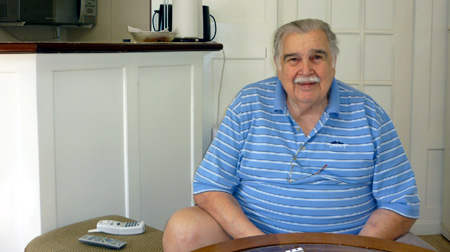 Mr. Orion Jardim de Faria, at ease in his home in São Paulo.
Picture taken by Paulo R. Elias. Mr. Orion Jardim de Faria, at ease in his home in São Paulo.
Picture taken by Paulo R. Elias.I came to speak with Orion de Faria at 9 A.M. on Saturday 15th of May, and found him in good mood and spirits. It took me less than five minutes to realize that I sat face to face with a man totally involved with the film business, not by profit but by passion. And rightly so, he went on speaking passionately about his life, his industry and about cinema in general. Orion’s involvement in the film business far exceeds his knowledge on how to manufacture a projector. It is in fact extensive to the point of getting acquainted with the many steps that are routinely taken when the movie itself is being made, inclusive of but not restricted to shooting, lab work, sound, printing, and so on. |
|
The interview | |
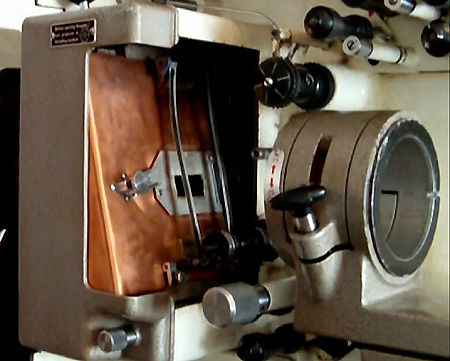 The DP70’s 70 mm stabilizer pressure springs at the projector’s
gate. The DP70’s 70 mm stabilizer pressure springs at the projector’s
gate.I initially asked him how did he manage to catch so much familiarity and awareness in the business. It so happened that Orion’s father, Alysson de Faria, was a college graduated engineer, who gathered his professional skills on mechanics and electronics. He also started his life as an entrepreneur and supplier of film equipment. This is where Orion got involved and accompanied his dad until he was mature enough to attend a crash course in projector mechanics and sound, given by Western Electric. But that was only the beginning. By uniting practice and theory on all topics regarding film prints and projection, he was able to build his first manufacturing plant in 1959, the “Indústrias Cinematográfica Orion Ltda”, or INCOL, for short. In 1958, however, Orion had already gone to the United States, in order to get acquainted with 70 mm film technology, and in the process, to study the Philips DP70 projector. Orion’s curiosity was aroused by the legend created by the Todd-AO filming process. His DP70 studies would eventually be the departure point for the creation of the Incol 70/35 model. — I studied the DP70, since it was the original projector intended for Todd-AO, he said. When I asked him if the Incol unit was a copy, he said that only the top threading sprockets and guides (including the positioning of the magnetic heads), and the film gate were of interest. He claims that what Philips had accomplished in the design of the film gate and intermittent sprocket of the DP70 was absolutely brilliant, and that he used it as an inspiration to make his own design. Some parts were admittedly and overtly copied, but many fundamental changes were also made. Philips best accomplishment in the film gate design, as Orion points out, is the use of a curved path and the simultaneous use of a couple of pressure springs for either 35 or 70 mm, resulting in a steady and quite “flat” film passage through the gate. |
|
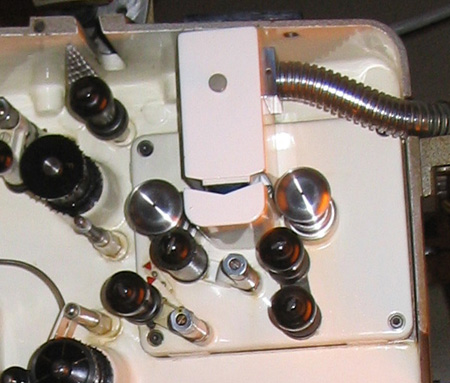 Close-up of the DP70 magnetic heads assembly. Close-up of the DP70 magnetic heads assembly.The Incol unit is indeed quite similar to the Philips at the projector gate, but however similarities would stop at that stage. The assembly of the magnetic heads are also built inside the projector’s head, but whereas the Philips approach would be to fixate the heads for 35 and 70 mm facing the film path at all times, through a suitable indentation, the Incol approach would be to build two separate heads for 35 and 70 mm film, one opposite the other. In this fashion, the projectionist would just have to rotate the assembly, in order to get one of the two formats read. A photographic comparison is shown below: Incol’s approach for magnetic sound capture is as good as the one used for the DP70. Orion imported the magnetic pick-ups from an Italian manufacturer. The final design of the assembly would guarantee the precise tracking of the film before the heads, and therefore an impeccable and perfectly aligned sound playback. Since eliminating reading distortion was not enough, Orion de Faria also designed his own set of six power amplifiers, capable of delivering up to 200 Watts R.M.S. per channel. “That kind of power”, he ponders, “was not necessary, due to the high efficiency of the speakers baffles used in theaters”. Obviously, he was referring to the design of the speakers that traditionally uses horn-type montages, for both woofers and mid-range/treble units. |
|
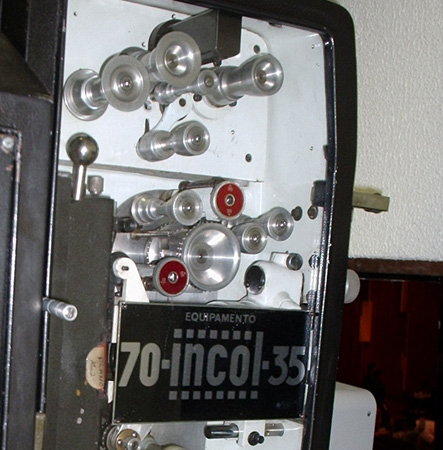 The Incol magnetic heads assembly (top, black) with
rotational, rather than fixed case. The Incol magnetic heads assembly (top, black) with
rotational, rather than fixed case.“My amps delivered real power, not alleged power supply, as some manufacturers claim”, he said. Well, as a matter of fact, I am testimony of the sound quality provided in many of the theaters equipped with the Incols. In some installations they would be limited only by the quality of the speakers or local acoustics. Orion himself made a significant number of theatrical installations. When it came to the speaker themselves the option was to either keep the theater’s own sets or replace them by the sets that he built in his factory. For the latter, he imported North-American drivers and built the enclosure locally, following the horn design. The decision to use custom made speakers or preserve the original theater speakers would be made by the exhibitor chain manager or by the theater owner. As a side comment, I was quite pleased to hear about the importance given to sound playback by Orion’s description of his design, since I have always been a sort of audiophile all my life, and also that sound was and still has been an important asset to the impact of film presentation and film making context throughout the years. It also acquired a special importance in the case of wide gauge screenings, due to the magnitude of the imagery. It is noteworthy that the Incol 70/35 projector could handle film projection at 30 frames per second as well as the standard 24 frames. Mr. de Faria said he got a gift from a Fox Film major executive of a 30 fps short documentary, which he used to demonstrate the projector’s full projection capability. It must also be noted that Orion designed the Incol 70/35 from scratch. In fact, during his studies of the Philips DP70, he made measurements of all components and parts, leaving the decision to make alterations afterwards, according to his needs and plant facilities. The DP70 provided the grounds of course, but the design decisions were all off Orion’s creativeness. |
|
Robustness and endurance of the Incol’s internal mechanics and parts | |
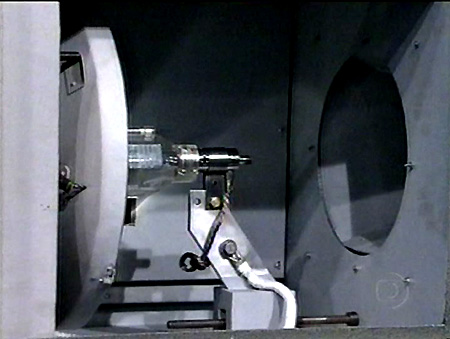 The Incol’s lamp house already exposed to the TV audience.
Copyright “Programa do Jô”, TV Globo, Brazil. The Incol’s lamp house already exposed to the TV audience.
Copyright “Programa do Jô”, TV Globo, Brazil.In the final design project of the Incol 70/35, Orion also made a number of interesting improvements: since the life span of a projector relies on the integrity of its mechanical parts, he made a decision to significantly simplify the number of internal components, thereby reducing the need for servicing. In fact, according to Orion, the Incol would work for more than a year virtually maintenance free. — The life span of many good projector systems, he said, usually lasts for about ten years in many theater installations. My Incols lasted much more than twenty years in the same theaters, and many of those are still operational elsewhere. The robustness of the Incol 70/35 projector would not be complete unless its lamp houses were not able to sustain a high current feed. Since 70 mm projection needs preferably light in abundance, the Incol lamp house was manufactured to withstand up to 140 amps, using the traditional voltaic arc with carbon rods. — There are two things that are very important in any theatrical presentation: the current supplied to the lamp house and the lenses used in the projectors. In the case of the Cinerama 70 built into the Roxy in Rio (his first installation of the Incols on these shores) my projectors used 130 amps in the lamp house and the owner imported a pair of a 13 element lens for the high curved screen. This set of lens was very heavy and precise. The basic difference between normal 70 mm projection and Cinerama 70 is primarily related to these lenses. But Orion de Faria was also a pioneer in the installation of Xenon bulbs and its adaptation to older lamp houses or in newly designed ones. Orion foresaw that carbon rods wouldn’t last long in the projection business, so he made a quick move to Xenon units, thereby designing new lamp houses for the Incols. |
|
The book and the TV show interview | |
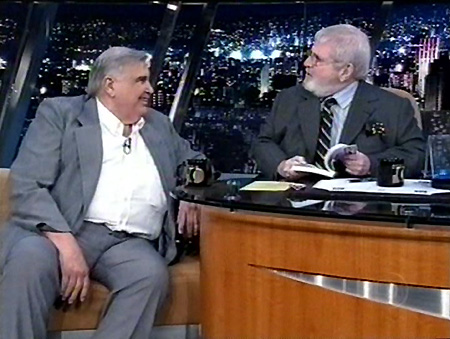 Orion Jardim de Faria (left) speaking to host Jô Soares,
whilst the latter holds his book in his hand. Copyright “Programa do Jô”,
TV Globo, Brazil. Orion Jardim de Faria (left) speaking to host Jô Soares,
whilst the latter holds his book in his hand. Copyright “Programa do Jô”,
TV Globo, Brazil.Approximately five years ago, Mr. de Faria decided to come publicly with a book he had written about world-wide cinema, and he did that in a TV show hosted by the renowned actor/writer Jô Soares. During my visit to him, I was granted a copy of the programme’s segment, taped on VHS off the air and saved on a DVD. Some screen captures are thus presented for the purpose of illustration: Curiously, Orion’s book concentrates much more in his revision and personal assessment of film making in various continents, rather than describing his manufacturing skills and design of his projectors. I had the chance to speak to him about the book, and since he is preparing a revised edition, I made a strong suggestion that he should dedicate a more detailed description of the Incol factory and the projectors, to the benefit of many readers. |
|
The end of an era | |
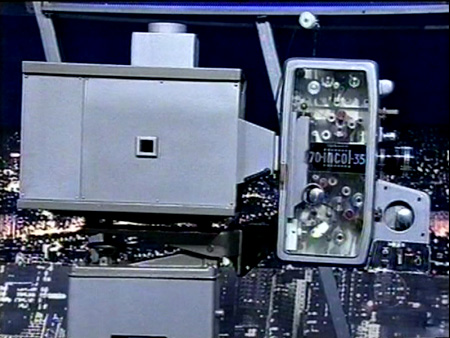 Orion’s 70/35 projector on stage! Copyright “Programa do Jô”,
TV Globo, Brazil. Orion’s 70/35 projector on stage! Copyright “Programa do Jô”,
TV Globo, Brazil.The Incol factory manufactured nearly one thousand projectors, amongst 16 mm, 35 mm, and 70 mm gauges, in various models. From these, around 178 Incol 70/35 units were built and sold. The first installation of the Incol 70/35 in Brazil was made in the city of São Paulo, at the Cine Scala. A blown-up copy of MGM’s “Gone With The Wind” was the first 70 mm print produced to patrons. At the time, a senior engineer of the Luis Severiano Ribeiro Group, owner of the main exhibitor chain in Rio de Janeiro, went to São Paulo and saw the Incols at work. In those days, the Ribeiro group was facing bankruptcy and would not be allowed to import new projectors. In fact, they had gone to the south of the country, namely to the city of Porto Alegre, in order to buy a pair of Philips DP70 units from a local exhibitor, and afterwards brought the DP70s to the Vitória, where they opened with the exhibition of “My Fair Lady”, as previously reported in this site. |
|
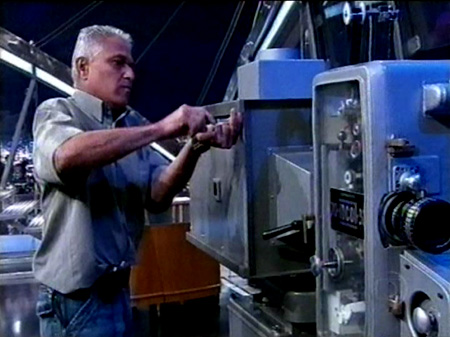 A former Incol’s technician preparing to open the projector’s
lamp house. Copyright “Programa do Jô”, TV Globo, Brazil. A former Incol’s technician preparing to open the projector’s
lamp house. Copyright “Programa do Jô”, TV Globo, Brazil.The first pair of Incol 70/35 was installed at the Roxy, for Cinerama 70. Its first screening was the exhibition of “Battle of the Bulge” in Ultra Panavision. The Severiano people were notorious for standardizing their projection equipment. Very soon they replaced the DP70s with the Incols at the Vitória and installed the newly bought units in no less than six of his theaters. The first screening at the Vitória with Incol projectors was made with the 70 mm version of Bob Fosse’s “Sweet Charity”, which, by the way, had already been exhibited at the Roxy Cinerama screen. I saw both presentations and I can firmly state that they were truly superb! |
|
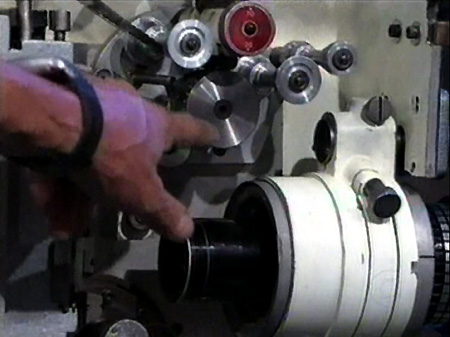 The technician explaining to the public how the film is thread
in the projector. Copyright “Programa do Jô”, TV Globo, Brazil. The technician explaining to the public how the film is thread
in the projector. Copyright “Programa do Jô”, TV Globo, Brazil.Incol units for 70 mm were also installed for other exhibitors too, and it was surely the omnipresent projector in Rio during the so called “70 mm craze” that lasted until the early 1990’s. During our conversation Orion denied that the Severiano group ever financed the acquisition of his 70 mm projectors via the Instituto Nacional de Cinema (INC), as previously reported to me. The Severiano administrators contracted the acquisition in instalments to him directly. The Incol factory started production in 1959, but it was not until 1968 that the first Incol 70/35 projector was sold to exhibitors. Up to 1980, Incol had purchased the Empresa Cinematográfica Triumpho, a Brazilian 35 mm projector industry created by designers Canteruccio and Lamana. He also acquired the mouldings of components and machinery from Inbelsa, a Philips subsidiary that made a fine line of Philips 35 mm projectors, still in use today. Some of the Philips moulds got astray, and were probably stolen, when the Incol factory moved to São Paulo. Orion saw no reason to keep the Philips plant open and decided to shut it down. In due course, its Triumpho branch would close down as well and Incol itself ceased operations in the beginning of the 1990’s. |
|
Mr. de Faria’s views on current film exhibition | |
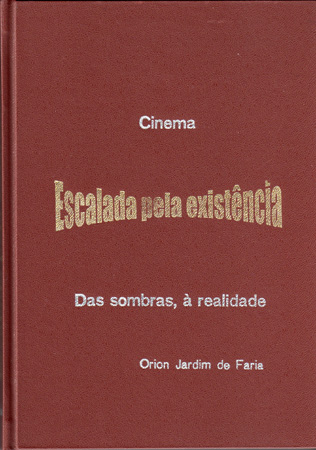 Mr. de Faria’s book front cover, in its first draft. Mr. de Faria’s book front cover, in its first draft.Orion de Faria firmly believes that the days of film projection are numbered, succumbing to digital projectors. He is in fact very fond of the DLP technology, although he admitted to me that he prefers film to video, and I fully agree. Film colours, he said, changed drastically over the years because of the way the film itself is being manufactured. He also said that even though theaters have all turned to the format of stadiums, which yield a more comfortable viewing of the screen, current installations are inferior to the older theater auditoriums, making patrons feel somewhat isolated. And to that, I should add that the sound playback is not so good, despite the best innovations of digital sound. After some three and a half hours speaking to a film pioneer, I left Orion’s presence with a feeling of unprecedented recognition of his contribution to the film industry, and identifying myself with most of the things he said so openly. I was grateful to have been given that chance, and I can only hope that Orion’s efforts will somehow place him among the people who made significant advances in film exhibition in this country. |
|
Acknowledgments | |
|
I would like to express my sincere
appreciation to my lifetime friend Evaldo da Costa Amorim, who
accompanied me and gave me directions during my visit to São Paulo. |
|
| Go: back - top - back issues - news index Updated 22-01-25 |
